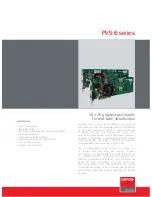
34
User's Guide HDSP System HDSP 9652
© RME
If several digital devices are to be used simultaneously in a system, they not only have to oper-
ate with the same sample frequency but also be synchronous with each other. This is why digi-
tal systems always need a single device defined as ‘master’, which sends the same clock signal
to all the other (‘slave’) devices.
RME’s exclusive
SyncCheck
technology (first implemented in the Hammerfall) enables an easy
to use check and display of the current clock status. The ‘SyncCheck’ field indicates whether no
signal (‘No Lock’), a valid signal (‘Lock’) or a valid
and
synchronous signal (‘Sync’) is present at
each of the digital clock source inputs. The
AutoSync Reference
display shows the current sync
source and the measured frequency.
In practice, SyncCheck provides the user with an easy way of checking whether all digital de-
vices connected to the system are properly configured. With SyncCheck, finally anyone can
master this common source of error, previously one of the most complex issues in the digital
studio world.
An example to illustrate this: The
ADAT1 and ADAT2 inputs are
receiving signals from a digital
mixing desk that has been set to
clock mode 'Internal' or 'Master'.
An ADAT recorder is connected
to the ADAT3 input. The Ham-
merfall DSP is set to AutoSync
mode. As expected, SyncCheck
shows that the ADAT1 and
ADAT2 inputs are in sync (as
they are driven by the same
clock from the mixing desk), but
shows ‘Lock’ instead of 'Sync' for the ADAT3 input. Because the ADAT recorder is not receiving
any signals from HDSP or from the mixer, it will generate its own clock at a rate which is (al-
most) the same as the sample frequency of the mixing desk - but not identical.
Remedy: To drive the ADAT recorder from its digital input, set it to slave mode (DIG), and con-
nect the input to the HDSP’s ADAT3 output. The Hammerfall DSP is already in sync with the
mixing desk, so it will send an identical (synchronous) signal to ADAT3 out. The ADAT recorder
will lock onto this, its output will also be in sync. The signal from the ADAT recorder is now fully
in sync with the signals from the mixing desk.
Thanks to its AutoSync technique and lightning fast PLLs, the HDSP is not only capable of han-
dling standard frequencies, but also any sample rate between 28 and 103 kHz. Even the word
clock input, which most users will use in varispeed operation, allows any frequency between 28
kHz and 103 kHz.
At 88.2 or 96 kHz: If one of the ADAT inputs has been selected in ‘Pref Sync Ref’, the sample
frequency shown in the field
SPDIF Freq.
differs from the one shown in ‘AutoSync Ref’. The
card automatically switches to S/MUX mode here, because ADAT optical inputs and outputs are
only specified up to 48 kHz. Data from/to a single input/output is spread over two channels, the
internal frequency stays at 44.1 or 48 kHz. In such cases, the ADAT sample frequency is only
half the SPDIF frequency.
Содержание Hammerfall HDSP 9652
Страница 5: ...User s Guide HDSP System HDSP 9652 RME 5 User s Guide HDSP 9652 General...
Страница 11: ...User s Guide HDSP System HDSP 9652 RME 11 User s Guide HDSP 9652 Driver Installation and Operation Windows...
Страница 29: ...User s Guide HDSP System HDSP 9652 RME 29 User s Guide HDSP 9652 Driver Installation and Operation Mac OS X...
Страница 38: ...38 User s Guide HDSP System HDSP 9652 RME...
Страница 39: ...User s Guide HDSP System HDSP 9652 RME 39 User s Guide HDSP 9652 Connections and TotalMix...
Страница 45: ...User s Guide HDSP System HDSP 9652 RME 45...
Страница 66: ...66 User s Guide HDSP System HDSP 9652 RME...
Страница 67: ...User s Guide HDSP System HDSP 9652 RME 67 User s Guide HDSP 9652 Technical Reference...
Страница 75: ...User s Guide HDSP System HDSP 9652 RME 75 31 Block Diagram HDSP 9652...
















































